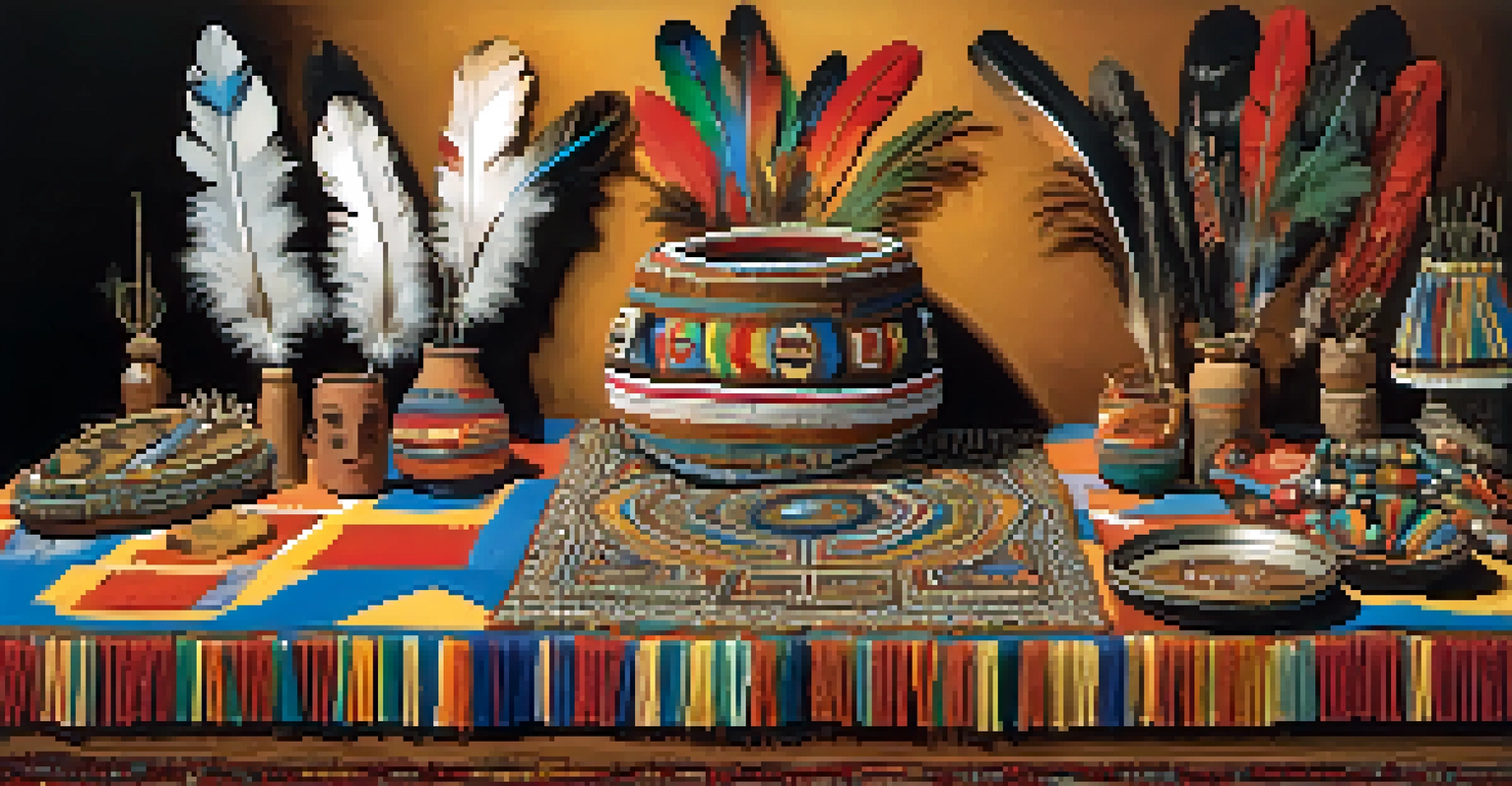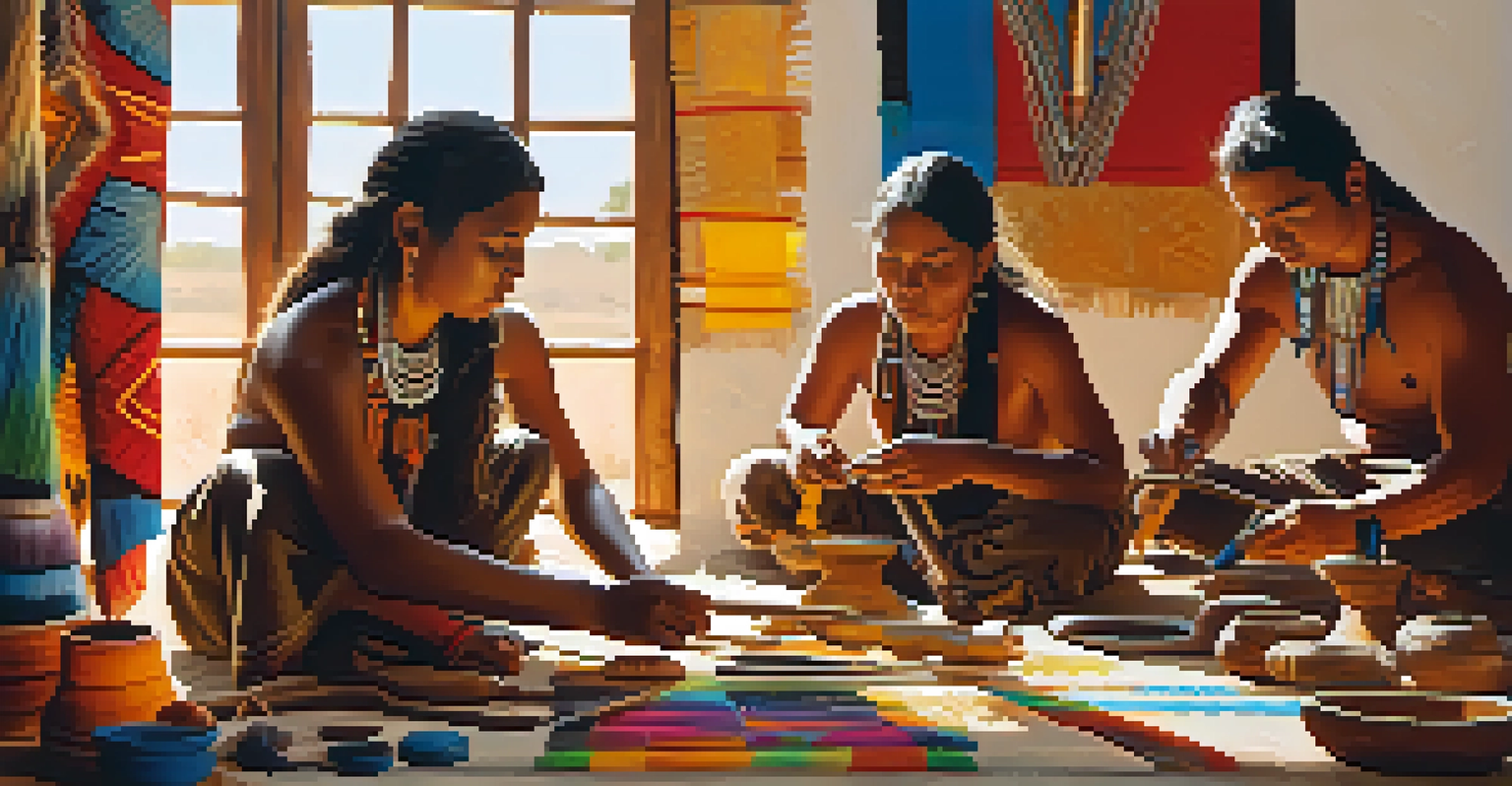The Role of Ceremonial Art in Indigenous Peyote Cultures

Understanding Peyote and Its Cultural Significance
Peyote, a small cactus native to Mexico and the southwestern United States, holds substantial spiritual significance for various Indigenous cultures. For many tribes, including the Huichol and the Native American Church, peyote is more than just a plant; it is a sacred teacher that facilitates connection with the divine. Its psychoactive properties are used in religious ceremonies, where it is believed to bring about visions and insights.
Art is the most beautiful of all lies; it is a window into the soul of a culture.
The ritualistic use of peyote is deeply intertwined with the cultural identity of these Indigenous peoples. The ceremonies surrounding peyote consumption often involve songs, prayers, and dances, all of which contribute to a shared spiritual experience. This communal aspect fosters a sense of belonging and reinforces cultural values, making peyote an integral part of their heritage.
Through these ceremonies, participants can explore profound themes of life, death, and existence, often leading to personal transformations. The experiences gained from peyote ceremonies are not just for individual enlightenment; they serve to strengthen community bonds and pass down traditions, ensuring that the cultural significance of peyote endures.
The Role of Ceremonial Art in Peyote Rituals
Ceremonial art plays a pivotal role in the rituals involving peyote, as it enhances the spiritual atmosphere and enriches the experience for participants. This art can take various forms, including intricate beadwork, paintings, and ceremonial attire, each piece imbued with cultural meaning. The vibrant colors and symbols used often represent various aspects of the natural world and spiritual beliefs.

For instance, the use of imagery depicting animals, plants, and celestial bodies often reflects the interconnectedness of all living things. This artistic expression not only beautifies the ceremony but also serves as a visual language that conveys the tribe's history and beliefs. By engaging in ceremonial art, practitioners can express their spirituality and honor their ancestors.
Peyote's Cultural Importance
Peyote serves as a sacred teacher in Indigenous cultures, facilitating spiritual connections and personal transformations during communal ceremonies.
Moreover, the act of creating and using ceremonial art fosters a sense of identity and continuity within the community. It allows artists to share their skills and knowledge, bridging generations and ensuring that traditional practices are preserved. In this way, ceremonial art becomes a living testament to the resilience and creativity of Indigenous cultures.
Symbolism in Ceremonial Art and Peyote Practices
Symbolism is a fundamental aspect of ceremonial art in Indigenous peyote cultures. Each symbol used in art and ritual holds specific meanings, often representing important cultural stories or teachings. For example, the spiral might symbolize the journey of life, while the sun can represent warmth, growth, and the spirit's illumination.
Tradition is not the worship of ashes, but the preservation of fire.
These symbols not only enhance the visual appeal of the ceremonies but also serve as a means of communication. They act as reminders of the values and lessons that are integral to the community's way of life. Participants often reflect on these symbols during peyote rituals, deepening their spiritual connection and understanding.
Additionally, the use of symbolism can vary between different tribes, showcasing the diversity within Indigenous cultures. This diversity adds layers of meaning to the ceremonies and allows for a rich tapestry of shared experiences, making each gathering unique yet connected through the overarching themes of spirituality and community.
The Process of Creating Ceremonial Art
Creating ceremonial art is often a communal endeavor, steeped in tradition and shared knowledge. Artists typically draw inspiration from their cultural heritage, utilizing techniques passed down through generations. This process not only involves artistic skill but also a deep understanding of the significance behind each piece being created.
For many Indigenous artists, this creation process is a form of meditation or prayer, connecting them to their ancestors and the spiritual realm. As they craft their art, they imbue it with intention and purpose, making each piece a vessel for their cultural stories and beliefs. This connection to the past and the present is what makes ceremonial art so powerful.
Role of Ceremonial Art
Ceremonial art enhances the spiritual atmosphere of peyote rituals, preserving cultural identity and bridging generations through shared artistic practices.
Moreover, the act of creating art together fosters community ties, reinforcing the idea that these rituals are not just individual experiences but collective ones. By participating in the creation of ceremonial art, community members reaffirm their shared identity and strengthen their bonds, ensuring that their cultural practices continue to thrive.
Ceremonial Art as a Means of Cultural Preservation
In Indigenous peyote cultures, ceremonial art serves as a crucial tool for cultural preservation. As these communities navigate the challenges posed by modernization and cultural assimilation, maintaining their artistic traditions is vital for keeping their heritage alive. Ceremonial art not only reflects their identity but also educates younger generations about their cultural history and values.
Through workshops and community events, elders often pass down artistic techniques and stories, ensuring that the knowledge is not lost. This intergenerational transmission is essential for cultural continuity, allowing younger members to take pride in their heritage while adapting it to contemporary contexts. It creates a sense of responsibility to honor and uphold these traditions.
Furthermore, showcasing ceremonial art in both local and broader contexts can help raise awareness about Indigenous cultures. By sharing their art with the world, these communities can foster appreciation and understanding, bridging gaps between cultures and promoting respect for their traditions.
The Impact of Globalization on Ceremonial Art
Globalization presents both challenges and opportunities for Indigenous peyote cultures and their ceremonial art. On one hand, the influence of outside cultures can dilute traditional practices, leading to a loss of authenticity. Some artists may feel pressured to modify their work to appeal to mainstream tastes, which can undermine the spiritual significance of their art.
On the other hand, globalization can also provide platforms for Indigenous artists to share their work with a wider audience. This exposure can foster appreciation for their culture and create economic opportunities. By selling their art in global markets, artists can gain recognition while simultaneously supporting their communities.
Globalization's Double-Edged Sword
While globalization poses challenges to traditional practices, it also offers Indigenous artists opportunities to share their work and gain recognition in broader markets.
Navigating these dynamics requires a delicate balance. Many Indigenous artists and communities are finding ways to engage with the global market while remaining true to their cultural roots. This adaptability not only helps preserve their traditions but also allows them to thrive in a rapidly changing world.
The Future of Ceremonial Art in Indigenous Peyote Cultures
The future of ceremonial art in Indigenous peyote cultures hinges on the ability to adapt while staying rooted in tradition. As younger generations become more involved in the creation and preservation of these practices, there is potential for innovative expressions that honor their heritage. This fusion of old and new can lead to exciting developments in how ceremonial art is created and experienced.
Community-driven initiatives that encourage artistic collaboration and education are crucial for sustaining these traditions. By fostering a supportive environment, Indigenous communities can empower their members to express their spirituality and cultural identity through art. This not only benefits the artists but also strengthens the community as a whole.

Ultimately, the future of ceremonial art lies in the commitment of Indigenous peoples to share their stories and practices with the world. By doing so, they can ensure that their cultural legacies continue to inspire and resonate, fostering a deeper understanding and respect for the importance of peyote and its ceremonial art.